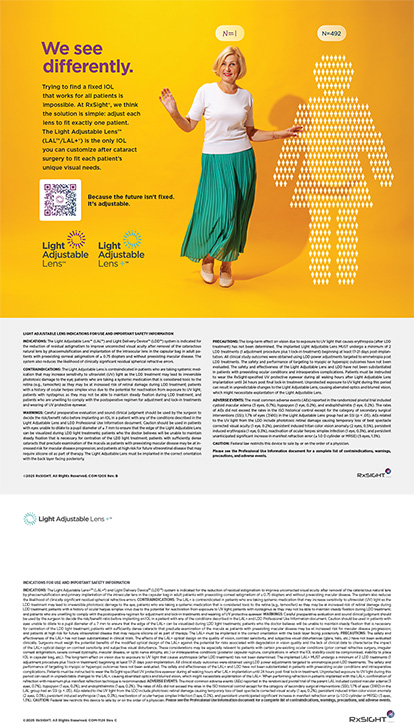My Updated Presbyopia-Correcting Algorithm
J. Morgan Micheletti, MD

Before a trifocal IOL became available in the United States, I routinely mixed and matched IOLs. Specifically, I implanted a Tecnis Symfony in the dominant eye and either a Tecnis Multifocal +3.25 D or a Tecnis Multifocal +4.00 D IOL (all IOLs from Johnson & Johnson Vision) in the nondominant eye. When I used this strategy, which Johnson & Johnson Vision referred to as the personalized vision approach, I typically performed cataract surgery on the dominant eye first. I would then assess patient satisfaction and range of vision at the 1-week follow-up visit. When patients were happy with their range of vision, I implanted a Tecnis Symfony IOL in the nondominant eye. If patients desired more near vision, however, I implanted a Tecnis Multifocal +3.25 D IOL in the nondominant eye as well. My patients achieved excellent outcomes and satisfaction with this approach,1 but extended patient counseling was required between surgeries.
WHEN TO MATCH, WHEN TO MIX
Matching IOLs. The FDA approval of the AcrySof IQ PanOptix trifocal IOL (Alcon) changed my presbyopia-correcting algorithm, and I now approach most cases with an IOL-matching strategy in mind. I implant the PanOptix IOL bilaterally in most of my premium IOL patients because I know it can provide a continuous range of vision with few visual dysphotopsias. In my experience, the intermediate focal point (60 cm) of the PanOptix helps my patients achieve comfortable vision for computer work. Chair time has also decreased because additional discussion about range of vision with patients is no longer required at the 1-week postoperative visit.
Mixing IOLs. I may consider mixing IOLs for patients who are concerned that visual dysphotopsias could affect their professional visual needs. Examples from my own experience include professional drivers, pilots, and law enforcement agents. In such situations, I prefer to implant an AcrySof IQ Vivity (Alcon) in the dominant eye and, if the patient requires more near vision, a PanOptix in the nondominant eye. If patients are happy with the range of vision in their first eye, however, I usually implant the AcrySof IQ Vivity bilaterally.
In my experience, patients who are not ideal candidates for multifocal IOL technology can be excellent candidates for the AcrySof IQ Vivity. I prefer the Vivity to other extended depth of focus IOLs because it has a visual disturbance profile similar to that of standard monofocal IOLs (data on file with Alcon). As a result, patients—especially those with a history of refractive surgery—are less likely to experience glare, halos, or starbursts after surgery.
FUTURE OUTLOOK
I am excited for the impending release of both the Vivity and PanOptix on the Clareon IOL (Alcon) platform. These IOLs are made of a new hydrophobic acrylic material that is produced with an enhanced manufacturing process.2 I think the PanOptix IOL on the Clareon platform will unlock more options for younger patients undergoing refractive lens exchange (off-label), as the concern for potential glistenings with the AcrySof platform may limit its use in the younger population. The material in the Clareon platform, however, should resolve these concerns. Multiple studies, including a 9-year follow-up study, have shown that the material is glistening-free.3-5
1. Koo OS, Kang JW, Park JK, Kim KH. Visual performance and patient satisfaction after implantation of extended range-of-vision IOLs: bilateral implantation vs 2 different mix-and-match approaches. J Cataract Refract Surg. 2021;47(2):192-197.
2. Nuijts R, Werner L, Auffarth G, Lane S. Clareon IOL: a new monofocal platform. The Ophthalmologist. October 2017. Accessed January 18, 2022. https://theophthalmologist.com/fileadmin/top/issues/1217/images/1217-900_Alcon_SS-new.pdf
3. Oshika T, Fujita Y, Inamura M, Miyata K. Mid-term and long-term clinical assessments of a new 1-piece hydrophobic acrylic IOL with hydroxyethyl methacrylate. J Cataract Refract Surg. 2020;46(5):682-687.
4. Stanojcic N, OʼBrart D, Hull C, Wagh V, Azan E, Bhogal M, Robbie S, Li JO. Visual and refractive outcomes and glistenings occurrence after implantation of 2 monofocal, aspheric, hydrophobic acrylic IOLs. J Cataract Refract Surg. 2020;46:986-994
5. Oshika T, Sasaki N. One-year multicenter evaluation of a new hydrophobic acrylic intraocular lens with hydroxyethyl methacrylate in automated preloaded delivery system. J Cataract Refract Surg. doi: 10.1097/j.jcrs.000000000000074
As IOL Technology Improves, There Is Less Reason to Mix and Match
Keith A. Walter, MD, FACS
I’m accustomed to achieving high patient satisfaction by mixing lenses, and the art of mixing and matching, for me, has evolved over the years. If I were writing an article on the subject a few years ago, I would have shared that my go-to combination was a Tecnis Symfony IOL in one eye and a Tecnis Multifocal +3.25 D IOL in the other or maybe even a Tecnis Multifocal +2.75 D for some rare cases. Earlier than that, I would have answered that I preferred to implant a monofocal lens in one eye and a Tecnis Multifocal +4.00 D IOL in the other.
Today, however, I am doing more matching and less mixing. I find there is less reason to mix IOLs because patients are often happy with the visual quality they can achieve with one IOL design.
WHEN TO MATCH
Presbyopia-correcting IOL technology has advanced significantly. Now when a patient is a good candidate for a multifocal or trifocal option, I tend to implant the same IOL bilaterally.
With the Tecnis Synergy (Johnson & Johnson Vision), I usually target a little bit of plus power because the lens provides a fuller range of vision than what previous presbyopia-correcting IOLs could provide. I do not push minus with this lens because I find that it can increase the amount of dysphotopsias and halos patients experience. I find that bilateral implantation of the Synergy can help patients achieve great reading vision while maintaining excellent uncorrected distance acuity.
Alternatively, for patients who want great distance vision and are not bothered by using reading glasses, I implant the Tecnis Eyhance (Johnson & Johnson Vision) bilaterally. This lens has a large sweet spot, and many patients end up seeing well at near for most of today’s needs, including computer and even cell phone use.
CONSIDERATIONS WHEN MIXING IOLS
Dominant or nondominant? Surgeons often contemplate if it is better to place the presbyopia-correcting IOL in the dominant or nondominant eye. I’ve done both, and in my experience, it hasn’t mattered because patients are binocular at most distances. In general, however, I place the presbyopia-correcting IOL in the first eye so that the patient achieves good distance vision and some intermediate vision with the first surgery.
Myopic target? Some surgeons like to set a myopic target in one eye. When I am mixing IOLs, however, I typically avoid this strategy because patients are more likely to see halos at night with a diffractive optic. Instead, I try to get as close to plano as I can or target slight hyperopia. I have also found that a mini-monovision strategy (eg, -0.75 or -1.00 D) with a presbyopia-correcting IOL in one eye is more likely to lead to patient complaints about spiderwebs or other dysphotopsias.
Mix-and-match with a blue-light–filtering IOL? The jury may be out on this, but I believe that it is safe to implant a presbyopia-correcting IOL in the second eye of patients who have a blue-light–filtering IOL in the first eye. In my experience, patients don’t notice a difference in color perception between their eyes.
CONCLUSION
The art of mixing IOLs can be a little trickier to master than the art of matching. For me, matching is the way to go now. When mixing IOLs works, however, it works well, and patients are happy. The key is giving patients more chair time and talking to them about what you’re doing and why you’re doing it.




